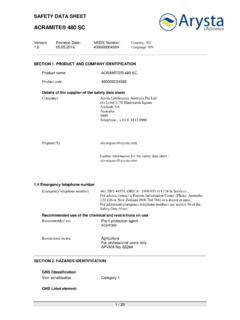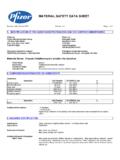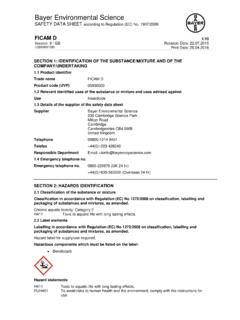Transcription of BISPHENOL A (BPA) - Current state of knowledge …
1 1 International Food Safety Authorities Network (INFOSAN) 27 November 2009 INFOSAN Information Note No. 5/2009 - BISPHENOL A BISPHENOL A (BPA) - Current state of knowledge and future actions by WHO and FAO SUMMARY NOTES BISPHENOL A (BPA) is a widely used chemical in polycarbonate plastic and epoxy resins Consumer exposure via food can occur through migration of BPA from food contact materials Concern has been raised because of potential toxic and hormonal properties of BPA Hazard assessments by major regulatory and advisory bodies are in agreement that the overall no-observed-adverse-effect level (NOAEL) for BPA from robust data is 5 mg/kg body weight/day. This is minimally five hundred-fold above conservative estimates of human exposure, including in bottle-fed infants. Several areas of uncertainty remain in the risk assessment of BPA: - effects have been reported from animal experiments on neurobehaviour following exposure to BPA during the developmental period at doses below the overall NOAEL; - kinetics of absorption, metabolism and excretion of BPA show important differences between primates, including humans (lower internal dose), and rodents, and between routes of exposure, so care is needed in extrapolation of animal studies to humans; - animal studies have not provided convincing evidence of risk of cancer from BPA exposure Introduction BISPHENOL A (2,2-bis(4-hydroxyphenyl) propane, CAS No.)
2 80-05-7) is a chemical used primarily as a monomer in the production of polycarbonate plastic (PC), and epoxy resins. It also has uses in polyester, polysulfone and polyacrylate resins, and flame retardants. Polycarbonate (PC) is widely used in food contact materials such as infant feeding bottles, tableware, microwave ovenware, food containers, water bottles, milk and beverage bottles, processing equipment and water pipes. Epoxy resins are used as protective linings for a variety of canned foods and beverages and as a coating on metal lids for glass jars and bottles, including containers used for infant formula. These uses result in consumer exposure to BPA via the diet. Daily dietary intakes, based on concentrations measured in food, vary widely, but have been estimated in Europe to be about g/kg body weight in breast-fed babies, g/kg body weight in formula-fed babies using non-PC bottles, 11 g/kg body weight in formula-fed babies using PC bottles, and g/kg body weight in adults.
3 Assessment of daily human exposure to BPA in the general population by biomonitoring of urinary excretion of BPA metabolites also varies widely, but has been estimated to be up to g/kg body weight in the USA, and g/kg body weight in Japan. The urine values may more accurately reflect the actual exposures since estimates based on dietary exposures assume 100% absorption and high consumer exposure scenarios. Food and Agriculture Organization of the United Nations 2 The scientific problem A very large number of publications on the toxicity and endocrine activity of BPA in animals have been published. Some of these studies have been performed in compliance with regulatory/OECD guidelines, using oral administration, large groups of animals and several dose groups. Many others have been research studies, often using smaller numbers of animals, fewer or single dose groups, and including non-oral routes of administration.
4 There have been considerable discrepancies in outcomes among these studies, both with respect to the nature of the effects observed and, where reported, the levels at which they occur. It is notable that effects have been described in some of the research studies at dose levels several orders of magnitude below those at which effects were reported in the guideline (regulatory) studies. This has led to controversy about the safety of BPA, not only among scientists, but also in the media, in national and state legislatures and in the general public. The key findings A number of effects of BPA in animals have been extensively investigated and target organs identified in repeat-dose animal studies include intestine, liver and kidney. However, the effects of most concern have been those related to the hormonal activity of BPA and potentially related effects on physical, neurological and behavioural development.
5 BPA acts as a weak oestrogen. It has a much lower affinity for the oestrogen receptors (ER and ER ) than endogenous oestrogen and it is rapidly metabolized to BPA-glucuronide which is not hormonally active. More recently, BPA has been shown to bind with high affinity to estrogen-related receptor (ERR- ), which may be related to its ability to function as a reported endocrine disruptor. In vivo studies have not consistently demonstrated either androgenic or anti-androgenic activity of BPA. Effects on the prostate/male reproductive tract have been reported following in utero exposure to oral doses as low as 2 g/kg bw/day; however, these findings have not been confirmed in studies conducted to OECD guidelines also including in utero exposure at similar low doses. Developmental toxicity studies have reported delays in onset of puberty at high dose levels (475mg/kg bw/day) in male and female rodents but no effect on subsequent fertility.
6 Numerous studies have shown that BPA up to very high oral dose levels of 640 or 1000mg/kg body weight, in rats and mice respectively, do not cause birth defects. Little information on the effects of BPA on development in humans is available. Several research studies in rodents of variable quality have suggested that BPA treatment during development can cause alterations in brain development and behaviour. The endpoints examined in these studies (behavioural changes related to stress, pharmacological challenges and sexual dimorphism) represent an emerging area in developmental neurotoxicity for which validated protocols are currently unavailable. These data suggest findings at doses that are relevant to human exposures; however, limitations of the studies for regulatory decision-making have been extensively discussed in the national and international risk assessment reports (see references).
7 The data, collectively, suggest that more research, using validated study methods and the oral exposure route may be necessary for conclusive risk assessment. OECD guidelines for animal testing have only recently included detailed guidance on behavioural and neurodevelopmental testing, and this is an expanding area of research. Although BPA does not demonstrate genotoxic potential in in vivo studies, concern has been expressed about possible carcinogenicity. Carcinogenicity studies conducted under the US National Toxicology Program, using F344 rats and B6C3F1 mice showed small increases in leukaemia and testicular interstitial cell tumours in male rats. However these studies have not been considered as convincing evidence of a potential cancer risk because of the doubtful statistical significance of the small differences in incidences from controls. An in utero exposure phase was not included in these studies, and there has been some limited evidence suggesting that there may be a risk of increase in susceptibility to precancerous changes in the prostate following neonatal exposure in rats.
8 3 Importance of comparative toxicokinetics In humans and other primates, orally administered BPA is rapidly absorbed and transformed to BPA-glucuronide during first pass metabolism in the gut wall and the liver and a small amount of BPA is converted to a sulphate conjugate. More than 80% of orally administered BPA is cleared from the body in 5 hours. The conjugated forms of BPA are devoid of endocrine activity. In rodents, orally administered BPA is also very rapidly glucuronidated, but is highly bound to plasma protein, excreted in the bile, cleaved again to free BPA and reabsorbed from the intestine into the blood stream. This enterohepatic recirculation may occur several times before BPA is finally excreted, mainly in the faeces, several days later. This results in slow elimination of BPA so that, for the same oral dose, rodents will have a prolonged higher exposure to free, oestrogenically active BPA, compared to primates.
9 In mice oxidation products of BPA have been identified after low-dose administration, suggesting possible formation of metabolites with higher oestrogenic potency. Due to the importance of first-pass metabolism of BPA, the value for human risk assessment of animal studies that have used non-oral routes of administration has been questioned. Kinetics also varies markedly with route of administration, dose, age and even gender. These differences have to be taken into account, especially with regard to interpretation of the significance for human health of low-dose effects observed in rodents. The presence of BPA in human fetal tissues at around the same concentrations as in maternal blood, demonstrates that BPA passes through the placenta. BPA also passes into maternal milk, resulting in concentrations of about 1-3 g/L, which are comparable with, or slightly higher than, those reported for maternal blood.
10 Thus, there is very low oral bioavailability of the parent substance, BPA, in humans, including the fetus. Toxicokinetic data suggest that embryonic/neonatal humans and animals lack the adult capacity to conjugate BPA, but neonates have capacity to metabolise BPA via sulphation. Maternal exposure to BPA results in embryos and newborns receiving BPA via placental transfer and milk. Exposure of human infants to BPA directly, in the absence of maternal transfer or excretion, also occurs through PC bottle feeding and/or infant formula feeding. The fetus and neonate may therefore be a sensitive and more highly exposed subpopulation deserving special attention. Risk assessments to date The key area in the risk assessment of BPA is the interpretation of a number of research studies reporting effects at very low dose levels in rodents. Some have posed difficulties in interpretation of the significance of their results for human health due to use of non-oral routes of administration, small numbers of animals, single dose levels, or, where more than one dose level had been used, absence of dose-response relationships.

















